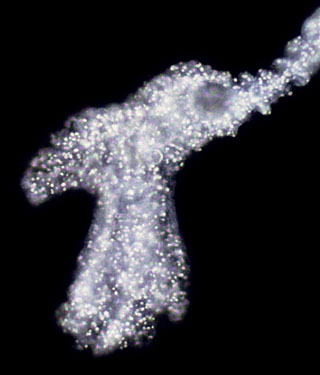|
Amoeba
proteus in different spot-lights
|
Illumination and contrast techniques for the light microscope |
|
Dark field |
|
 |
The darkground is very useful in revealing very fine detail especially bacteria that would otherwise be almost impossible to see. The condenser must have a numerical aperture higher than the objective. If a round patch stop of the correct size is introduced to the substage condenser the central rays are blocked out. The rays of light that are scattered by the object enter the front lens of the objective giving a very bright image of the protozoan, flagella or bacterium against a very black background. The amateur can achieve this method by experimenting with various patch stop sizes on low power objectives. Most microscope manufacturers make their own darkground condensers, and to use a high power objective for this type of contrast enhancement a purpose built darkfield condenser must be employed. |
|
This photograph shows an amoeba with the numerous crystals that are found in this species showing up against a dark background. The photograph is taken with a Leitz x25 water immersion bright field objective with a numerical aperture of 0.60, while the condenser was a Leitz D 0.80 dry condenser. |
|
Back to An Introduction to Microscopy
Microscopy
UK Front Page
Micscape Magazine
Article Library
text & Image © Steve Durr 1999
Web design: Wim van Egmond


